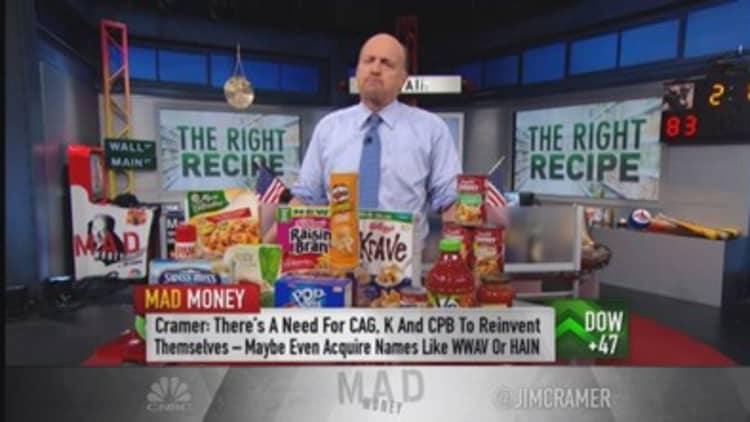The Republican-controlled House Committee on Agriculture on Wednesday begins two days of hearings on the nation's food stamp program, and they'll be watched closely by more than just the hungry.
Observers expect the committee to step up efforts to restore work requirements, seek to close certain loopholes and look to review the current level of funding. There's also projected to be testimony about reports of misuse and abuse by beneficiaries pf "SNAP"—or the Supplemental Nutrition Assistance Program, as it's formally known.
The federal food assistance program for low-income Americans grew dramatically during the Great Recession as unemployment increased and more households became eligible for the benefits. But a year after legislative cuts to the SNAP program made headwinds for Wal-Mart Stores and other retailers catering to shoppers with lower incomes, there's also interest from the retail industry on whether cuts could be on the way.
"When SNAP benefits were cut in November 2013, we saw a lot of these retailers struggle with their same-store sales results," said Peter Keith, a retail analyst at Piper Jaffray. "If there was a further cut, it would absolutely be negative to these retailers catering to lower-income customers."
Read More The 2 industries that are fighting over your power bill
Last year, monthly average enrollment in SNAP was approximately 46.5 million Americans, up from about 26.3 million in 2007. Moreover, total spending on the program increased to about $74.1 billion in 2014 from about $33.2 billion in 2007, according to the U.S. Department of Agriculture.
Wednesday will include the full committee conducting a "top-to-bottom review of the SNAP program," according to the House agenda. It will be followed by Thursday's nutrition subcommittee hearing "to better understand the SNAP population through published research."
"We're past the recession now—and spending should be down, and it's not," said Michael Tanner, a senior fellow at the Cato Institute, a libertarian think tank. "More than half of the spending is from people who have been on the program five years or more. So what you're getting is much more long-term use, much less safety-net use, and that's what some Republicans want to look at."

The full committee hearing will be presided over by Rep. K. Michael Conaway, R-Texas, the chairman of the House Agriculture Committee and a trained CPA. Another key member will be Rep. Jackie Walorski, R-Ind., a two-term member who serves on the ag committee and chairs the recently created nutrition subcommittee, which has responsibility for the SNAP program.
In the past, Conaway has blasted the food stamp program and cited Government Accountability Office studies showing overpayments to food stamp recipients as well as reports of recipients selling their food stamps on Craigslist or buying alcohol and cigarettes with the payments.
Conaway declined to comment for this story.
"It's not perfect, and we need to drive toward perfection," said Stacy Deal, vice president for food assistance policy at the Center on Budget and Policy Priorities, a nonpartisan policy research organization based in Washington. "But it does pretty darn well. SNAP rolled out as a national response to the issue of hunger in our country. And we just don't hear about those kind of problems the way we used to."
Read More
Meanwhile, about 1 million people are slated to be removed from the program starting next year because of a limit on benefits for unemployed childless and nondisabled households. Moody's estimates that SNAP expenditures have a ripple effect on the economy, producing $1.73 in economic stimulus for every $1 spent on benefits.
When SNAP benefits were cut back by $5 billion in November 2013 with the elimination of the incremental stimulus funding, the effects were felt by Wal-Mart, other grocers, discounters and dollar stores. The Farm Bill, signed into law last year by President Barack Obama, is slated to cut an additional $8 billion in SNAP spending over the next 10 years.
The lower gasoline prices are certainly helping right now. SNAP benefits do seem to be an important traffic driver to these stores every month.Peter Keithretail analyst, Piper Jaffray
Packaged food companies also are at risk of SNAP cuts, particularly those such as Kraft Foods Group, Campbell Soup and ConAgra Foods that are seen as skewed toward the low-income consumer. That said, the overall is likely to help cushion some food stamp reductions.
"The lower gasoline prices are certainly helping right now," said Piper Jaffray's Keith. "SNAP benefits do seem to be an important traffic driver to these stores every month."
Michele Buck, president of North America for The Hershey Co., said at a conference last week that there was a decline in consumer trips to stores last year, "which was accelerated due to pressure on low- and middle-income consumers and a reduction in SNAP benefits."
Post Foods and Campbell Soup had earlier estimated that SNAP reductions had a nearly 1 percent drag on category volumes after the benefits reduction.


